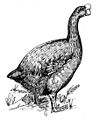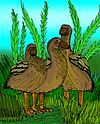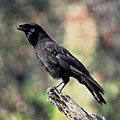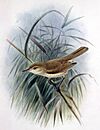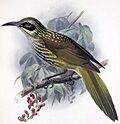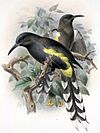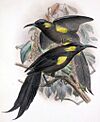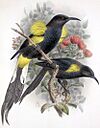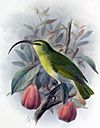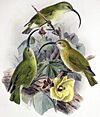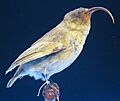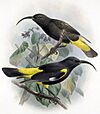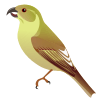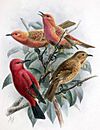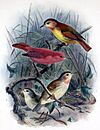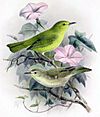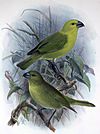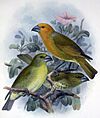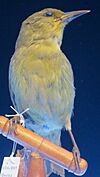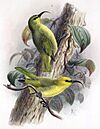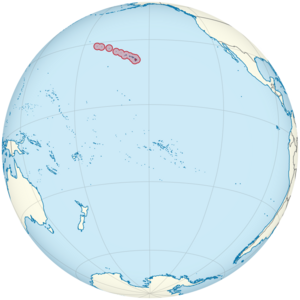
Location of Hawaii in the Pacific Ocean.
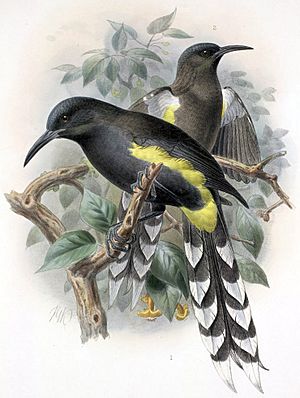
The
O‘ahu ‘ō‘ō (
Moho apicalis) is one of many bird species that disappeared after people arrived in Hawaii.
This article is about animals that have disappeared from Hawaii during the Holocene epoch. This is the most recent geological time period, which started about 11,650 years ago and continues to this day.
The Hawaiian Islands are a group of islands in the Pacific Ocean. They include eight main islands and many smaller islands and atolls. Most of them are part of the U.S. state of Hawaii. Only Midway Atoll is a separate U.S. territory.
Hawaii was one of the last places on Earth settled by humans. The first people, Polynesians, arrived between 1219 and 1266 CE. Later, in 1778, British explorer James Cook was the first European to reach Hawaii. After him, many European and American explorers, traders, and whalers came to the islands. Hawaii became part of the United States in 1898 and a state in 1959.
Many species have disappeared from Hawaii because of human activities. When Polynesians and later Europeans arrived, they changed the environment a lot. They cleared native forests and brought in new plants and animals, some for farming and some by accident. These changes caused many unique Hawaiian species to disappear. For example, fossils show that Hawaii once had its own native eagle, two types of large crows, several meat-eating owls, and giant ducks called moa-nalo. Today, many of Hawaii's remaining unique plants and animals are endangered. Hawaii has lost more of its special species than any other U.S. state. For instance, the native plant Brighamia now needs people to pollinate it by hand because its natural pollinator is gone.
This list only includes native Hawaiian animals, not domestic animals like the Hawaiian poi dog. The exact dates when many species disappeared are not known.
Mammals
Bats
Vesper bats
Birds
Waterfowl
Ducks, geese, and swans
| Common name |
Scientific name |
Range |
Comments |
Pictures |
| Nēnē-nui |
Branta hylobadistes |
Maui, possibly Oahu and Kauai |
The most recent remains of this large goose are from 1046-1380. |
|
| Giant Hawaiʻi goose |
Branta rhuax |
Hawaii (island) |
The most recent remains are from 1380-1500. |
|
| Turtle-jawed moa-nalo |
Chelychelynechen quassus |
Kauai |
This unique duck is only known from old bone remains. |
|
| Small-billed moa-nalo |
Ptaiochen pau |
Maui |
This duck is known from old bone remains. It probably lived in the mountains. It likely disappeared due to hunting and new mammals. |
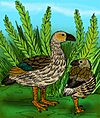
Small-billed moa-nalo (right)
|
| Kauaʻi mole duck |
Talpanas lippa |
Kauai |
The most recent remains are from 3540-3355 BCE. This duck could not fly, was active at night, and was almost blind. It was very easy for hunters and new animals to catch. |
|
| Oʻahu moa-nalo |
Thambetochen xanion |
Oahu |
The most recent remains are from 440-639 CE. It likely disappeared due to hunting, habitat loss, and new mammals eating its eggs. |
|
| Maui Nui large-billed moa-nalo |
Thambetochen chauliodous |
Maui and Molokai |
The most recent remains are from 1057-1375. It lived in lower areas, while the small-billed moa-nalo lived higher up. It likely disappeared due to hunting and Polynesian rats eating its eggs. |

Maui Nui large-billed moa-nalo (left)
|
Rails and cranes
Rails
| Common name |
Scientific name |
Range |
Comments |
Pictures |
| Laysan rail |
Zapornia palmeri |
Laysan |
This bird disappeared from Laysan in 1923 after feral rabbits ate all the plants. It was moved to other islands to save it, but then black rats were accidentally brought to Midway Atoll in 1943, and they wiped out the rails there by 1945. |
|
| Hawaiian rail |
Zapornia sandwichensis |
Hawaii (island) |
The last one was collected in 1864. It lived peacefully with the Polynesian rat but might have been killed by the black rat. Hunting, loss of forests, and new diseases also likely played a part. |
|
Albatrosses and petrels
Petrels and shearwaters
| Common name |
Scientific name |
Range |
Comments |
| Oʻahu petrel |
Pterodroma jugabilis |
Hawaii (island) and Oahu |
Old bones of this bird were found where people used to live, so it's thought that people hunted it. |
Pelicans, herons, and ibises
Ibises and spoonbills
| Common name |
Scientific name |
Range |
Comments |
Pictures |
| Maui highland ibis |
Apteribis brevis |
Maui |
The most recent remains are from 170 BCE - 370 CE. |
|
| Molokaʻi ibis |
Apteribis glenos |
Molokai |
This bird is known from prehistoric times. |
Hawks and relatives
Hawks, eagles, kites, harriers and Old World vultures
| Common name |
Scientific name |
Range |
Comments |
Pictures |
| White-tailed eagle |
Haliaeetus albicilla |
Oahu, Molokai, and Maui |
Fossils show this eagle lived in Hawaii for over 100,000 years. It was the biggest predator there. Its disappearance might be linked to human changes, but we don't have direct proof it lived at the same time as humans. |
|
Owls
True owls
| Common name |
Scientific name |
Range |
Comments |
| Kauaʻi stilt-owl |
Grallistrix auceps |
Kauai |
The most recent remains are from 744-202 BCE. |
| Maui stilt-owl |
Grallistrix erdmani |
Maui |
The most recent remains are from 1057-1440 CE. |
Perching birds
Crows and relatives
| Common name |
Scientific name |
Range |
Comments |
Pictures |
| Hawaiian crow |
Corvus hawaiiensis |
Hawaii (island) and Maui |
This crow was hunted in the 1800s. The last wild pairs were seen in 1992, with only 11 or 12 birds left. The last pair was seen in 2002. There are some in zoos, but attempts to release them failed. |
|
Reed warblers
| Common name |
Scientific name |
Range |
Comments |
Pictures |
| Laysan millerbird |
Acrocephalus familiaris familiaris |
Laysan |
Last seen in 1913. It likely disappeared because feral rabbits ate almost all the plants on the island by 1920. |
|
Hawaiian honeyeaters
| Common name |
Scientific name |
Range |
Comments |
Pictures |
| Kioea |
Chaetoptila angustipluma |
Hawaii (island), Oahu, and Maui |
The last one was collected in 1859. Loss of forests, hunting, and new predators likely caused its disappearance. |
|
| Oʻahu ʻōʻō |
Moho apicalis |
Oahu |
Last seen in 1837. It probably disappeared due to habitat loss and diseases carried by mosquitos. |
|
| Bishop's ʻōʻō |
Moho bishopi |
Maui, Lanai, and Molokai |
Last seen on Molokai in 1904. It declined due to habitat loss for farming and grazing animals, then was wiped out by black rats and diseases. |
|
| Kauaʻi ʻōʻō |
Moho braccatus |
Kauai |
This bird was common before the 1890s. By 1981, only one pair was left. The female disappeared in a hurricane in 1982, and the male sang alone until 1987. It likely declined due to habitat loss, predators like black rats and feral pigs, and diseases from mosquitos. |
|
| Hawaiʻi ʻōʻō |
Moho nobilis |
Hawaii (island) |
Last seen in 1934. It likely disappeared due to habitat loss and disease. |
|
Thrushes
| Common name |
Scientific name |
Range |
Comments |
Pictures |
| Kāmaʻo |
Myadestes myadestinus |
Kauai |
Last reliably seen in 1985. Likely disappeared due to diseases from new mosquitos, and forests being destroyed by feral pigs. |
|
| ʻĀmaui |
Myadestes woahensis |
Oahu |
Known from only one bird collected in 1825 and old bones. The reason for its disappearance is unknown, but habitat loss and bird malaria are suspected. |
|
Possibly extinct, thrushes
| Common name |
Scientific name |
Range |
Comments |
Pictures |
| Olomaʻo |
Myadestes lanaiensis |
Maui, Lanai and Molokai |
It might have disappeared from Maui in the 1800s. Last seen on Lanai in 1933, and on Molokai in 1980. It could have been wiped out by diseases from new mosquitos and habitat destruction. |
|
True finches
| Common name |
Scientific name |
Range |
Comments |
Pictures |
| Oʻahu ʻakialoa |
Akialoa ellisiana |
Oahu |
Only two specimens of this bird were collected in 1837. It's thought to have disappeared due to habitat loss and disease. |
|
| Maui Nui ʻakialoa |
Akialoa lanaiensis |
Maui, Lanai and Molokai |
Named from three birds collected on Lanai in 1892. Fossils were also found on Molokai and Maui. It's believed to have disappeared due to habitat loss, disease, and possibly new species. |
|
| Lesser ʻakialoa |
Akialoa obscura |
Hawaii (island) |
Last reported in 1940. Likely disappeared due to forests being cut down and new diseases. |
|
| Kauaʻi ʻakialoa |
Akialoa stejnegeri |
Kauai |
Last reported in 1969. Disappeared due to forest clearing and new diseases. |
|
| Kona grosbeak |
Chloridops kona |
Hawaii (island) |
By the time it was discovered in the late 1800s, it lived in a very small area. The last one was collected in 1894. The reasons for its disappearance are unknown, but might include habitat loss, new mammal predators, and avian malaria. |
|
| ʻUla-ʻai-hawane |
Ciridops anna |
Hawaii (island) |
Last collected in 1892. The reasons for its disappearance are unknown, but cutting down forests, malaria, and rats eating them might have played a part. |
|
| Black mamo |
Drepanis funerea |
Maui and Molokai |
Last collected in Molokai in 1907. It probably disappeared because its forest home was destroyed by new cattle and deer, and by rats and mongooses. |
|
| Hawaiʻi mamo |
Drepanis pacifica |
Hawaii (island) |
Last recorded in 1898. Even though it was heavily hunted for its feathers, it was likely habitat loss and disease that caused its final disappearance. |
|
| Lānaʻi hookbill |
Dysmorodrepanis munroi |
Lanai |
Only known from one bird collected in 1913. It likely disappeared because forests were cleared for pineapple farms, and by cats and rats. |
|
| Oʻahu nukupuʻu |
Hemignathus lucidus |
Oahu |
The last two birds were collected around 1838-1841. |
|
| Laysan honeycreeper |
Himatione fraithii |
Laysan |
Disappeared after new feral rabbits ate almost all the plants on the island. The last three birds died in a storm in 1923. |
|
| Oʻahu ʻakepa |
Loxops wolstenholmei |
Oahu |
Last recorded in 1930. Probably disappeared due to habitat loss and disease. |
|
| Poʻouli |
Melamprosops phaeosoma |
Maui |
The last two birds were recorded in 2004; one died soon after being caught. The exact reasons for its decline are unknown. It could be habitat loss, diseases from mosquitos, pigs, rats, cats, and small Indian mongooses. |
|
| Kākāwahie |
Paroreomyza flammea |
Molokai |
Last recorded in 1961-1963. It's thought to have disappeared due to habitat loss and disease. |
|
| Lānaʻi ʻalauahio |
Paroreomyza montana montana |
Lanai |
Disappeared in 1937. |
|
| Lesser koa finch |
Rhodacanthis flaviceps |
Hawaii (island) |
This bird seemed to disappear due to habitat loss, not climate changes or mosquito-borne diseases. It was last recorded in 1891. |
|
| Greater koa finch |
Rhodacanthis palmeri |
Hawaii (island) |
Last collected in 1896. The reasons for its disappearance are unknown, but habitat loss and new avian malaria are likely causes. |
|
| Greater ʻamakihi |
Viridonia sagittirostris |
Wailuku River, Hawaii (island) |
Last recorded in 1901. Its only known forest home was cleared to plant sugar cane. |
|
Possibly extinct, true finches
| Common name |
Scientific name |
Range |
Comments |
Pictures |
| Maui nukupuʻu |
Hemignathus affinis |
Maui |
Last confirmed sighting in 1896. Its forest home was destroyed for cattle ranching or damaged by new animals. New plants and disease-carrying mosquitos also spread. |
|
| Kauaʻi nukupuʻu |
Hemignathus hanapepe |
Kauai |
Last confirmed sighting in 1899. It likely declined due to habitat damage by new animals, disease, and competition with new birds and insects. |
|
| Maui ʻakepa |
Loxops ochraceus |
Maui |
Last recorded in 1988. It could have declined due to habitat loss, new diseases, and competition with new species. |
|
| Oʻahu ʻalauahio |
Paroreomyza maculata |
Oahu |
Last collected in 1968 and last well-documented sighting in 1985. It may have disappeared due to disease spread by new mosquitos. |
|
| ʻŌʻū |
Psittirostra psittacea |
Hawaii (island), Maui, Molokai, Lanai, Oahu, and Kauai |
Last certainly recorded in Hawaii in 1987, and in Kauai in 1989. It disappeared from Oahu, Maui, Molokai, and Lanai between 1899 and 1931. It may have disappeared due to habitat loss, new rats, and malaria spread by new mosquitos. |
|
Insects
Dragonflies and damselflies
Narrow-winged damselflies
Possibly extinct
| Common name |
Scientific name |
Range |
Comments |
| Maui upland damselfly |
Megalagrion jugorum |
Maui and Lanai |
Last seen in 1917. It is thought to be possibly extinct. |
Grasshoppers, locusts, and crickets
True crickets
Extinct in the wild
| Common name |
Scientific name |
Range |
Comments |
| Oʻahu deceptor bush cricket |
Leptogryllus deceptor |
Oahu |
This cricket is extinct in the wild, meaning it only exists in captivity, if at all. |
True bugs
Mealybugs
| Scientific name |
Range |
Comments |
| Clavicoccus erinaceus |
Oahu |
This mealybug is extinct. Last seen in 1963. |
| Phyllococcus oahuensis |
Hawaiian Islands |
This mealybug is extinct. |
Beetles
True weevils
| Common name |
Scientific name |
Range |
Comments |
|
Dryophthorus distinguendus |
Nearly all of the Hawaiian Islands |
This weevil is extinct. Last seen in 1961. |
| Laysan weevil |
Oodemas laysanensis |
Laysan |
This weevil is extinct. Last seen in 1964. |
|
Rhyncogonus bryani |
Laysan |
This weevil is extinct. Last seen in 1911. |
Butterflies and moths
Pyralid moths
Owlet moths
| Common name |
Scientific name |
Range |
Comments |
| Confused moth |
Helicoverpa confusa |
Hawaiian Islands |
Extinct after 1927. |
| Minute noctuid moth |
Helicoverpa minuta |
Hawaiian Islands |
Last seen before 1911. Considered extinct. |
| Laysan dropseed noctuid moth |
Hypena laysanensis |
Laysan |
Last seen in 1911. Considered extinct. |
Possibly extinct, owlet moths
| Common name |
Scientific name |
Range |
Comments |
Pictures |
| Midway noctuid moth |
Agrotis fasciata |
Midway Atoll |
Last seen before 1960. Considered possibly extinct. |
|
| Kona agrotis noctuid moth |
Agrotis panoplias |
Hawaii (island) |
Date unknown. Considered possibly extinct. |

Kona agrotis noctuid moth
|
| Laysan noctuid moth |
Agrotis laysanensis |
Laysan |
Last seen in 1911. Considered possibly extinct. |
|
Geometer moths
| Common name |
Scientific name |
Range |
Comments |
Pictures |
| Kona giant looper moth |
Scotorythra megalophylla |
Hawaiian Islands |
Last seen in the early 1900s. Considered extinct. |
|
| Koʻolau giant looper moth |
Scotorythra nesiotes |
Oahu |
Last seen in the early 1900s. Considered extinct. |
|
True flies
Long-legged flies
| Common name |
Scientific name |
Range |
Comments |
Pictures |
| Koʻolau spurwing long-legged fly |
Campsicnemus mirabilis |
Hawaiian Islands |
This fly is extinct. |
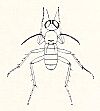
Koʻolau spurwing long-legged fly
|
Fruit flies and relatives
| Common name |
Scientific name |
Range |
Comments |
| Lanai pomace fly |
Drosophila lanaiensis |
Lanai and possibly Oahu |
Last seen in 1893. This fly is extinct. |
Snails and slugs
Land snails
Achatinellidae family
| Scientific name |
Range |
Comments |
Pictures |
| Achatinella abbreviata |
Oahu |
Extinct. Last seen in 1963. |
|
| Achatinella apexfulva |
Oahu |
Extinct. The last individual died in a zoo in 2019. |
|
| Achatinella buddii |
Oahu |
Extinct. Last seen in the early 1900s. |
|
| Achatinella casta |
Oahu |
Extinct. Date unknown. |
|
| Achatinella livida |
Oahu |
Extinct. Collected several times between 1981 and 1993. |
|
| Achatinella valida |
Oahu |
Extinct. Last seen in 1951. |
|
| Auriculella expansa |
Maui |
Extinct. Seen in 1946 and 1960. |
|
| Partulina crassa |
Lanai |
Extinct. Last seen in 1914. |
|
Amastridae family
| Scientific name |
Range |
Comments |
Pictures |
| Amastra cornea |
Oahu |
Extinct. Date unknown. |
|
| Amastra crassilabrum |
Oahu |
Extinct. Seen in 1951. |
|
| Amastra elongata |
Oahu |
Extinct. Date unknown. |
|
| Amastra subsoror |
Maui |
Extinct. Last seen in 1946. |
|
| Carelia bicolor |
Kauai |
Extinct. Last seen in 1970. |
|
| Carelia cochlea |
Kauai |
Extinct. Seen in 1952. |
|
| Carelia dolei |
Kauai |
Extinct. Seen in 1952. |
|
| Carelia turricula |
Kauai |
Extinct. Last seen in 1930. |
|
Images for kids
See also





